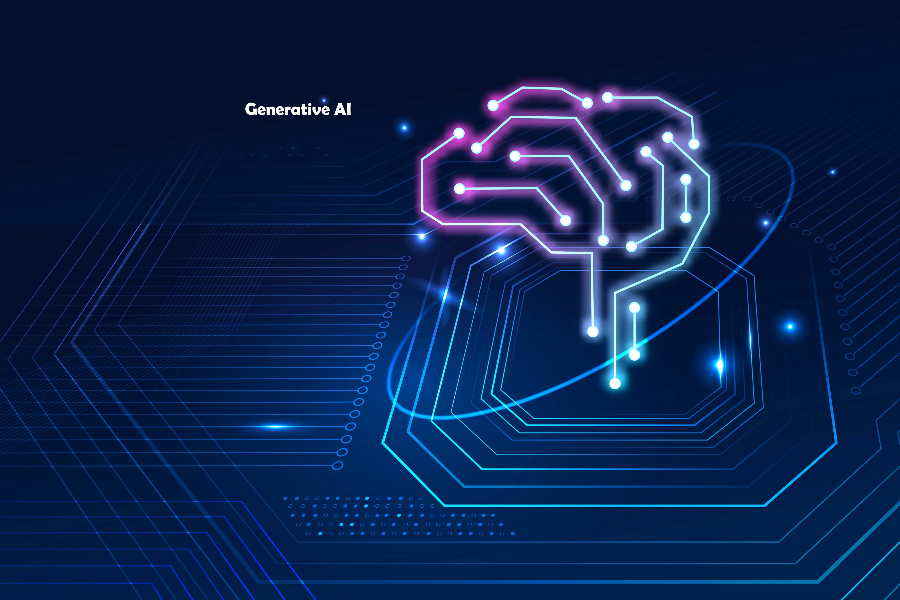Unleashing Creativity: The Power of Generative AI
In recent years, the field of artificial intelligence (AI) has witnessed a remarkable advancement known as Generative AI. This groundbreaking technology has the ability to create content, art, and even human-like text, pushing the boundaries of what AI can achieve. In this blog post, we’ll explore the fascinating world of Generative AI, its applications, ethical considerations, and its impact on the IT industry that comes with it.
Exploring Generative AI
Generative AI, a subset of artificial intelligence, stands apart by concentrating on the generation of novel data, content, or media rather than mere processing and interpretation of existing information. This technology harnesses the potential of neural networks, specifically a class known as generative models, to yield fresh outputs that often exhibit unexpected levels of creativity and realism.
Diverse Facets of Generative AI
There are several types of Generative AI models, but the two most prominent ones are:
- Generative Adversarial Networks (GANs): GANs employ a dual neural network system comprising a generator and a discriminator, engaged in a competitive dialogue. While the generator fabricates content, the discriminator evaluates its authenticity. This adversarial interplay drives the generator to continually refine its output, resulting in progressively lifelike creations.
- Recurrent Neural Networks (RNNs): RNNs, renowned for their aptitude in sequential data generation, prove well-suited for tasks such as text generation, speech synthesis, and musical composition. Variations like LSTM (Long Short-Term Memory) and GRU (Gated Recurrent Unit) have bolstered RNNs’ generative capabilities.
Applications of Generative AI
Generative AI has permeated diverse domains, with notable applications encompassing:
Art and Design: Generative AI has revolutionized the world of digital art. Artists and designers use GANs to create unique and imaginative pieces, sometimes collaborating with AI as a creative partner.
Content Generation: The proliferation of AI-generated content in news articles, marketing materials, and even video game narratives is on the rise. AI demonstrates its prowess in producing text, images, and videos on a grand scale, aiding content creators and marketers alike.
Language Translation: Language models, exemplified by Open AI’s GPT, have heralded a transformation in machine translation. They facilitate the seamless translation of text between languages, albeit challenges persist in handling nuances and idiomatic expressions.
Drug Discovery: Generative AI plays a pivotal role in expediting drug discovery within the pharmaceutical industry. It proposes novel molecular structures with potential therapeutic benefits, expediting the research process.
Simulation and Training: AI-driven simulations offer realistic scenarios for training purposes, particularly in fields such as aviation, medicine, and military training.
Ethical Contemplations
As Generative AI becomes more powerful, ethical concerns arise
Misinformation: The capacity of AI to craft highly convincing fake content raises concerns about the proliferation of misinformation and deep fakes. Society necessitates the development of safeguards against the inappropriate application of this technology.
Bias and Fairness: Generative models often internalize biases present in their training data, perpetuating stereotypes and disparities. Vigorous efforts are essential to mitigate bias in AI systems.
Privacy: The generation of lifelike faces and personal data by AI raises pertinent concerns regarding privacy and informed consent.
Creative Control: An ongoing debate persists in creative industries regarding the role of AI in artistic processes, with concerns about its potential to replace human creativity.
Generative AI in the booming IT industry
AI has a profound impact on the IT industry by enhancing automation, improving efficiency, and enabling new capabilities in various aspects of IT operations. It is likely that the influence of generative AI will continue to grow as technology evolves and businesses seek innovative ways to leverage AI for IT needs. Its responsible development and usage require robust security measures to mitigate risks and protect sensitive data. Some of the major sectors that have an impact on Generative AI are Software development, Natural Language processing, Cyber Security, Network Management, IT security, and Data Analytics.
Conclusion
Generative AI constitutes a thrilling frontier within the realm of artificial intelligence, adept at producing content that is both creative and utilitarian across a multitude of applications. However, the responsible development and deployment of this technology necessitate meticulous consideration of its ethical and societal ramifications. Striking an equilibrium between creativity, innovation, and ethical standards will emerge as a paramount challenge as we continue our exploration of the vast potential offered by Generative AI.
Source
- https://azumo.com/insights/the-power-of-generative-ai-a-complete-guide-for-business
- https://www.ibm.com/topics/artificial-intelligence#:~:text=At%20its%20simplest%20form%2C% 20artificial,in%20conjunction%20with%20artificial%20intelligence.
- https://www.ibm.com/topics/recurrent-neural-networks
- https://generativeai.net/
- https://www.gartner.com/en/topics/generative-ai
- https://www.analyticsvidhya.com/blog/2023/07/unleashing-creativity-exploring-generative-ai-artistic-applications/#:~:text=Generative%20AI%20algorithms%20have %20significantly,coherent%20and%20imaginative%20written%20pieces.
- https://www.bitsathy.ac.in/generative-ai/

